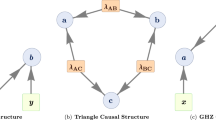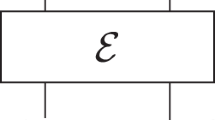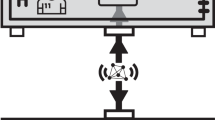Abstract
Inferring causal relations from experimental observations is of primal importance in science. Instrumental tests provide an essential tool for that aim, as they allow one to estimate causal dependencies even in the presence of unobserved common causes. In view of Bell’s theorem, which implies that quantum mechanics is incompatible with our most basic notions of causality, it is of utmost importance to understand whether and how paradigmatic causal tools obtained in a classical setting can be carried over to the quantum realm. Here we show that quantum effects imply radically different predictions in the instrumental scenario. Among other results, we show that an instrumental test can be violated by entangled quantum states. Furthermore, we demonstrate such violation using a photonic set-up with active feed-forward of information, thus providing an experimental proof of this new form of non-classical behaviour. Our findings have fundamental implications in causal inference and may also lead to new applications of quantum technologies.
This is a preview of subscription content, access via your institution
Access options
Access Nature and 54 other Nature Portfolio journals
Get Nature+, our best-value online-access subscription
$29.99 / 30 days
cancel any time
Subscribe to this journal
Receive 12 print issues and online access
$209.00 per year
only $17.42 per issue
Buy this article
- Purchase on Springer Link
- Instant access to full article PDF
Prices may be subject to local taxes which are calculated during checkout



Similar content being viewed by others
References
Wright, P. G. et al. Tariff on Animal and Vegetable Oils (1928).
Angrist, J. D., Imbens, G. W. & Rubin, D. B. Identification of causal effects using instrumental variables. J. Am. Stat. Assoc. 91, 444–455 (1996).
Greenland, S. An introduction to instrumental variables for epidemiologists. Int. J. Epidemiol. 29, 722–729 (2000).
Balke, A. & Pearl, J. Bounds on treatment effects from studies with imperfect compliance. J. Am. Stat. Assoc. 92, 1171–1176 (1997).
Pearl, J. Causality. (Cambridge Univ. Press, Cambridge, 2009).
Brunner, N., Cavalcanti, D., Pironio, S., Scarani, V. & Wehner, S. Bell nonlocality. Rev. Mod. Phys. 86, 419–478 (2014).
Pearl, J. On the testability of causal models with latent and instrumental variables. In Proc. Eleventh Conf. on Uncertainty in Artificial Intelligence 435–443 (Morgan Kaufmann, 1995).
Bell, J. S. On the Einstein–Podolsky–Rosen paradox. Physics 1, 195–200 (1964).
Leifer, M. S. & Spekkens, R. W. Towards a formulation of quantum theory as a causally neutral theory of bayesian inference. Phys. Rev. A 88, 052130 (2013).
Fritz, T. Beyond Bell’s theorem II: Scenarios with arbitrary causal structure. Commun. Math. Phys. 341, 391–434 (2016).
Procopio, L. M. et al. Experimental superposition of orders of quantum gates. Nat. Commun. 6, 7913 (2015).
Rubino, G. et al. Experimental verification of an indefinite causal order. Sci. Adv. 3 (2017), https://doi.org/10.1126/sciadv.1602589.
Henson, J., Lal, R. & Pusey, M. F. Theory-independent limits on correlations from generalized bayesian networks. New J. Phys. 16, 113043 (2014).
Chaves, R., Majenz, C. & Gross, D. Information–theoretic implications of quantum causal structures. Nat. Comm. 6, 5766 (2015).
Pienaar, J. & Brukner, C. A graph-separation theorem for quantum causal models. New J. Phys. 17, 073020 (2015).
Costa, F. & Shrapnel, S. Quantum causal modelling. New J. Phys. 18, 063032 (2016).
Allen, J.-M. A, Barrett, J., Horsman, D. C., Lee, C. M. & Spekkens, R. W. Quantum common causes and quantum causal models. arXiv preprint arXiv:1609.09487 (2016).
Fitzsimons, J., Jones J. & Vedral, V. Quantum correlations which imply causation. arXiv preprint: 1302.2731 (2013).
Ried, K. et al. A quantum advantage for inferring causal structure. Nat. Phys. 11, 414–420 (2015).
MacLean, J.-P. W., Ried, K., Spekkens, R. W. & Resch, K. J. Quantum-coherent mixtures of causal relations. Nat. Comm. 8, 15149 (2017).
Schafer, J. L. & Kang, J. Average causal effects from nonrandomized studies: a practical guide and simulated example. Psychol. Methods 13, 279–313 (2008).
Giacomini, S., Sciarrino, F., Lombardi, E. & De Martini, F. Active teleportation of a quantum bit. Phys. Rev. A 66, 030302 (2002).
Sciarrino, F., Ricci, M., De Martini, F., Filip, R. & Mista, L. Realization of a minimal disturbance quantum measurement. Phys. Rev. Lett. 96, 020408 (2006).
Ringbauer, M. et al. Experimental test of nonlocal causality. Sci. Adv. 2 (2016), https://doi.org/10.1126/sciadv.1600162.
Boyd, S. & Vandenberghe, L. Convex Optimization. (Cambridge Univ. Press, Cambridge, 2004).
Bonet, B. Instrumentality tests revisited. in Proc. 17th Conf. Uncertainty in Artificial Intelligence 48–55 (Morgan Kaufmann, 2001).
Popescu, S. & Rohrlich, D. Quantum nonlocality as an axiom. Found. Phys. 24, 379–385 (1994).
Carvacho, G. et al. Experimental violation of local causality in a quantum network. Nat. Commun. 8, 14775 (2017).
Saunders, D. J., Bennet, A. J., Branciard, C. & Pryde, G. J. Experimental demonstration of nonbilocal quantum correlations. Sci. Adv. 3 (2017) https://doi.org/10.1126/sciadv.1602743.
Ringbauer, M. & Chaves, R., Probing the non-classicality of temporal correlations, arXiv preprint arXiv:1704.05469 (2017).
Vazirani, U. & Vidick, T. Fully device-independent quantum key distribution. Phys. Rev. Lett. 113, 140501 (2014).
Pironio, S. et al. Random numbers certified by Bell’s theorem. Nature 464, 1021–1024 (2010).
Colbeck, R. & Kent, A. Private randomness expansion with untrusted devices. J. Phys. A 44, 095305 (2011).
Colbeck, R. & Renner, R. Free randomness can be amplified. Nat. Phys. 8, 450–453 (2012).
Gallego, R. et al. Full randomness from arbitrarily deterministic events. Nat. Commun. 4, 2654 (2013).
Brandão, F. G. S. L. et al. Robust device-independent randomness amplification with few devices. Nat. Commun. 7, 11345 (2016).
Mayers, D. & Yao, A. Self testing quantum apparatus. Quant. Inf. Comput. 4, 273–286 (2004).
Chaves, R., Kueng, R., Brask, J. B. & Gross, D. Unifying framework for relaxations of the causal assumptions in Bell’s theorem. Phys. Rev. Lett. 114, 140403 (2015).
Toner, B. F. & Bacon, D. Communication cost of simulating Bell correlations. Phys. Rev. Lett. 91, 187904 (2003).
Hall, M. J. W. Local deterministic model of singlet state correlations based on relaxing measurement independence. Phys. Rev. Lett. 105, 250404 (2010).
Barrett, J. & Gisin, N. How much measurement independence is needed to demonstrate nonlocality? Phys. Rev. Lett. 106, 100406 (2011).
Acknowledgements
R.C. and L.A. acknowledge financial support from the Brazilian ministries MEC and MCTIC. In addition, L.A. is also grateful to the Brazilian agencies CAPES, CNPq, FAPERJ and INCT-IQ for financial support. This work was supported by the ERC-Starting Grant 3D-QUEST (3D-Quantum Integrated Optical Simulation; grant agreement number 307783): http://www.3dquest.eu, and QUCHIP-Quantum Simulation on a Photonic Chip grant agreement number 641039. G.C. thanks Becas Chile and Conicyt for a doctoral fellowship.
Author information
Authors and Affiliations
Contributions
G.C., I.A, V.D.G, S.G. and F.S. devised and performed the experiment; R.C. and L.A. developed the theoretical tools; all authors discussed the results and contributed to the writing of the manuscript.
Corresponding authors
Ethics declarations
Competing interests
The authors declare no competing financial interests.
Additional information
Publisher’s note: Springer Nature remains neutral with regard to jurisdictional claims in published maps and institutional affiliations.
Electronic supplementary material
Supplementary Information
Supplementary Figures 1–6, Supplementary Tables 1–2.
Rights and permissions
About this article
Cite this article
Chaves, R., Carvacho, G., Agresti, I. et al. Quantum violation of an instrumental test. Nature Phys 14, 291–296 (2018). https://doi.org/10.1038/s41567-017-0008-5
Received:
Accepted:
Published:
Issue Date:
DOI: https://doi.org/10.1038/s41567-017-0008-5
This article is cited by
-
Experimental nonclassicality in a causal network without assuming freedom of choice
Nature Communications (2023)
-
Fresh perspectives on the foundations of quantum physics
Nature Reviews Physics (2023)
-
Entanglement-based quantum communication complexity beyond Bell nonlocality
npj Quantum Information (2022)
-
Experimental violation of n-locality in a star quantum network
Nature Communications (2020)
-
Experimental device-independent certified randomness generation with an instrumental causal structure
Communications Physics (2020)



